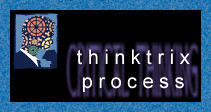

Tripod Home | New | TriTeca | Work/Money | Politics/Community | Living/Travel | Planet T | Daily Scoop

The Thinktrix can help you develop a better understanding of how to solve problems and make decisions -- two processes essential to your success in life and in the workplace. Efficient and thorough critical thinking can increase your value at work and, thereby, your job security. In this time of flux in the work world, that can't hurt.
Recall: Facts, sequence, and description. This is the simplest action; it builds on the most basic observation by telling facts or describing events, or by putting them into sequence. "On Tuesdays and Thursdays at 12:30 p.m. I have a regular lunch meeting scheduled with my supervisor."Similarity: Analogy, likeness. With this action you look at what is similar about one or more things, comparing them to one another. "I have to log the rent payment again today -- let me look in the records for how I did it last month, it is the exact same amount and process as before."
Difference: Distinction, contrast. This action deals with what is different about one or more things; you contrast them with one another. "The three sales reps all work full time but Alex is always in the office, Jack telecommutes from the road two out of every four weeks, and Felicia works at home two days out of the week."
Cause and effect: Consequence or result, prediction. Using this action, you look at what causes have led (or could lead) to what effects, or what effects trace back to what causes. You are looking at the consequences of an event, fact, or phenomenon. "When one person stays home sick, it causes everyone else in the department to have to step up the pace and do extra work, perhaps even stay late that day to pick up the slack."
Example to idea: Generalization, classification. From one or more facts or events, you develop a general idea. You classify one or more facts or events, or you find a pattern and generalize about several of them. "Ellis can stay longer at work because his company's in-house day care saves him from having to spend time commuting back and forth to drop off or pick up his daughter. Marlene is able to feed her baby during the day at her company's center on the first floor, and that has allowed her to return to work sooner. Gena's company has teamed up with a day care on the first floor of the building that gives employees a special deal. From these examples, I have come up with the idea that we open our own day care."
Idea to example: Categorization, substantiation. In a reverse of the previous action, you begin with an idea and think of events or facts that back up that idea. "Having meetings first thing in the morning is problematic. Examples to back this up include last week when all the train commuters got delayed in the snowstorm, yesterday morning when an urgent priority came up and took three people away from the meeting, and the fact that many employees here prefer to take care of unfinished business and phone calls first thing before starting any new work."
Evaluation: Value, judgment, rating. Here you judge whether something is right or wrong, good or bad, important or unimportant, identifying and weighing its positive and negative effects (pros and cons). "Is it good for me to drive to work? Positive effects: I enjoy driving, I can catch up on the news on the radio, I have the freedom to go somewhere right away when I need to, I don't have to shell out for a train or bus pass. Negative effects: I get stuck in traffic often, I have to pay for gas and car maintenance and parking, I have to be awake and alert to drive carefully, I occasionally risk parking tickets. Hmm..."
Test Yourself With An Example Problem From Keys to Success, by Carol Carter and Sarah Lyman Kravits, adapted for Tripod by the authors. Copyright (c) 1996 by Prentice-Hall, Inc., a Simon & Schuster Company.
Map | Search | Help | Send Us Comments